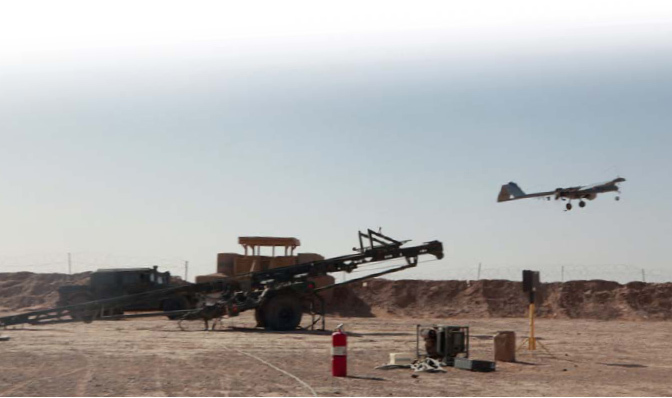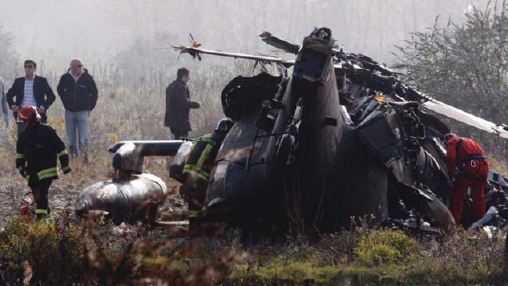
A shadow observation drone launches. Drones or UAVs are increasingly changing the nature of SF missions. (USMC)
A crunch and then a pair of crunches as the mortar rounds land. Probably Chinese 82mm. Only one bomb comes down inside the perimeter of the trenches and you hear the shrapnel whistle over your head. Someone shouts something unprintable and not very witty – probably a new recruit. The old soldiers don’t make a fuss about mortars when they are dug in. Someone starts to play a harmonica. One of those sad, haunting songs that remind you of home and which are beloved of soldiers the world over. Most soldiers find home looks a lot better from the bottom of a foxhole some thousands of miles away. A shadow whispers as it passes. Just a corporal checking the sentries are awake. The rest of the night passes quietly.
First light
There have been sentries on watch with night-vision gear all through the darkness but as the first light gives you a view of the mist over the river you have the men ‘Stand to’ ready for a dawn attack. More tradition from the Zulu wars than anything else it gives the men a sense of organization and rhythm to the day.
The clearing patrol goes out to check for enemy preparing to attack or the tracks of anyone visiting to take a look in the night. When they return it seems a couple of the opposition have come up as far as the 50 yard wire without being seen. The only trace they have left is drag marks as they have slowly wriggled over the soft ground amongst the weeds. Did they come to count you or to mark your position for artillery? The smell of bacon drifts across the camp and mess tins rattle. The men are in good spirits. Life is easy and the weather is warm and dry. Camping is great fun in good weather.
Routine
The radio operator has picked up a signal from Division to HQ asking why an armed drone was sent over a friendly state’s territory. Apparently it had fired rockets at a village full of civilians and killed 17 people. Women and children of course. You wonder if they are talking about your harmless little drone. The argument is raging 5,000 miles away in an embassy somewhere between men in suits drinking cups of civilized coffee. Reality is what is agreed and is therefore negotiable.
A familiar gentle whistling has just become noticeable. It is growing in volume and you know what it is if you can just place it... You scream, ‘Take cover!’. The volume goes off the scale as the whistle turns into something like an express train. Then the sky falls, the earth shakes and part of your foxhole caves in.
As consciousness returns you remember what the sound was – heavy artillery. Three 155mm rounds were dropped on your position to make a diplomatic point. Thank God they were just high explosive and not bunker-busters, air burst or phosphorous. You take a walk around the camp and discover there were no casualties but the men look shaken. A reasonable reaction. You report this back to HQ and discover your boss already knew. The opposition were trying to use the made-up drone incident as a cover to take you out entirely with heavy artillery. Your boss heard via a high altitude drone and told them their artillery would be destroyed if they continued firing so it seems there will be no more artillery from the other side of the bridge – probably. Nice to know someone is watching over you and there are some rules to the game.
You’ve watched the bridge for six days now and there has not been above a dozen mortar rounds fired or a sighting of the enemy or a track that can’t be identified. Nothing. You’ve let the men play football on the killing ground during the middle of the day.

A search team accompanied by some ‘Spooks’ check out a downed Blackhawk helicopter. (Corbis)
Re-supply
For all the difference it makes, it’s Saturday. Signals report the re-supply chopper is approaching. It’s going to be a winch-drop of an under-slung load: water, canned rations, fresh meat and fruit. There will probably be mail too but no more booze than the grunts can smuggle in because the CO back at base doesn’t like it. Someone shouts they can see the chopper coming in. It is losing height and approaching your position about a mile away. You call ‘Stand to’ in case of attack while your men are watching the chopper. The men go to their places cheerful and expectant – every soldier loves a letter.
Three trails of smoke from the river tree line converge on the chopper and it turns into a ball of flame. The ball plummets to the ground a quarter mile from your position. The camp goes quiet. Soldiering is always the same: 99% boredom and 1% terror. You call in the event on the radio and a fleet of gunships come to circle the area while a team search for survivors and classified material. There are none of either. Another chopper, this time covered by a pair of gunships circling high, delivers your supplies before dark. Someone on the other side of the river has decided to raise the stakes.
Working nights
Another week has almost passed and it has seemed like a month. Nothing but a few stray mortars every night to keep you awake. A week in a place like this is a good rest but much longer and it gets boring. Things could be much worse – a long foot patrol in the sun over soft sand for a start. But you don’t want to get too relaxed as a smart enemy always hits you at the beginning or end of a tour. The beginning before you find your feet and get the men trained, the end because you are getting sloppy. Even now night visibility aids are in common use, most fighting still goes on at night. There is still an advantage in the cover of darkness.
A forced whisper brings you scrambling across the camp. The sentry watching the bridge has a sighting report. It looks like there is a gathering of people at the far end of the bridge. Years ago you would have acted on your initiative but now communications have come so far, someone else can carry the buck for this one. Are the enemy massing to come over the bridge or are a group of foreign nationals out for a night-time stroll? Possibly worse, has someone gathered together a bunch of refugees to drive them over the bridge. Are they a human shield?
A video link sends back the night-scope pictures to HQ. As has been traditional for hundreds of years in military circles, HQ comes back with clear, definite orders: ‘If it’s the enemy you must stop them, if there are civilians amongst them they must not be harmed.’ So you know where you stand. Your choice is simple – you either do nothing and risk letting the enemy across the bridge with the consequent failure of your mission or you open fire and risk killing civilians. Ethics is not an integral part of military training. Rather, pragmatism is raised to an art form. You have the machine gunners loose off a few bursts in front of the crowd to let them know you have the bridge covered. No one is hit but the crowd breaks and you can hear screaming and shouting – then single shots. Looks like the opposition were herding civilians across the bridge in front of them and have shot a couple to calm them down. A radio message comes in that both Divisional airfields are under sustained attack and aircraft are grounded for the time being. It’s started.
Uninvited guests
From all around the perimeter of your camp signals are coming that the enemy is approaching on foot and in some strength. Perhaps 500 men are surrounding you. You give the order and the men hold their fire. It seems the incident on the bridge was a distraction from the approach of a strong infantry force. How did they get within a quarter mile without your sentries seeing them? They knew where the dead ground made a hidden approach possible and it explains why they eliminated the drone. Mortar bombs start to come down on the position in ones and twos. Maybe the visitors the other night were there to get the range right. Certainly their mortar shooting is good and getting better. Enough to make you want to keep your head down anyway and that is just what the enemy wants.